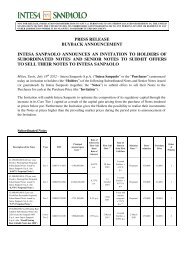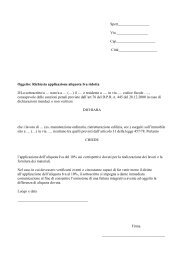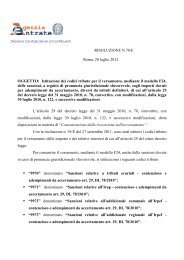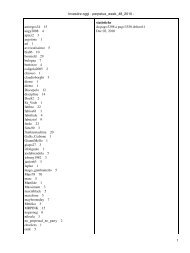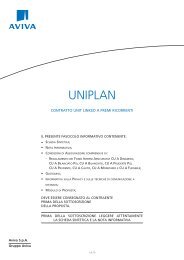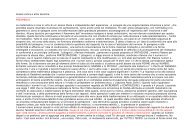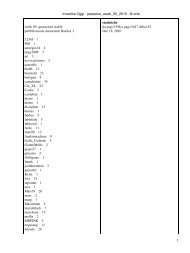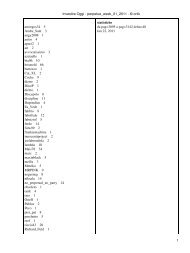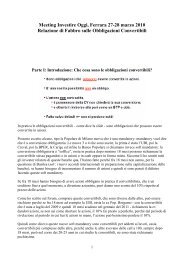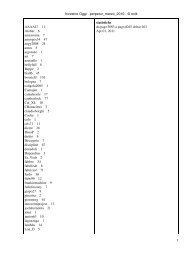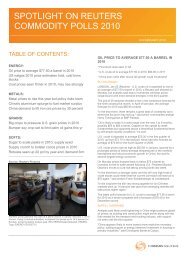Generali - InvestireOggi
Generali - InvestireOggi
Generali - InvestireOggi
You also want an ePaper? Increase the reach of your titles
YUMPU automatically turns print PDFs into web optimized ePapers that Google loves.
Alan Bowe<br />
(44-20) 7134-1837<br />
alan.m.bowe@jpmorgan.com<br />
ESR based on a 99.5%<br />
confidence level whilst not<br />
perfect is a good indication of<br />
where their SII SCR ratio would<br />
be.<br />
Update on Sale of BSI – Banca<br />
de Gottardo – book value of<br />
€2.3bn and goodwill of €555.7m<br />
as of 1H 2012.<br />
Risk reduction in financials via<br />
switches into covered bonds out<br />
of senior unsecured<br />
Europe Credit Research<br />
11 October 2012<br />
Strategic update<br />
As of the August 1, 2012, Mario Greco was officially appointed Group CEO of<br />
<strong>Generali</strong>. We understand the new CEO has undertaken a full strategic and financial<br />
review of <strong>Generali</strong> in light of current market conditions. We expect that one of the<br />
key subjects will be on solvency levels given the weakness, exposed by the sovereign<br />
debt crisis, to large swings in AFS reserves, especially given the transition to<br />
Solvency II expected with the next 1-2yr period (depending on delays). We look at<br />
the following potential options with regards to increasing solvency on a forward<br />
looking basis.<br />
Dividend management<br />
In our opinion a payout ratio of 40% may not be compatible with an Economic<br />
Solvency Ratio (ESR) (99.5% confidence) of 151% or a Solvency I ratio of 130%<br />
given the expected low interest rate environment and worsening European economic<br />
outlook. As such we would expect an adjustment of the payout ratio that better<br />
reflects a more conservative approach to capital retention. For example if they were<br />
to halve their payout ratio, based on the 1H 2012 run rate this could improve<br />
<strong>Generali</strong>'s Solvency I ratio by 2ppts.<br />
Divestments<br />
We expect <strong>Generali</strong> to continue to consider divestments as a method to improve<br />
efficiency and potentially improve solvency. We note the recent agreement to sell<br />
Migdal, <strong>Generali</strong>’s Israeli insurance operations, to Eliahu Insurance Company for<br />
€705m. This is expected to improve <strong>Generali</strong>’s Solvency I ratio by 2.2ppts once the<br />
deal closes by the end of October. We expect there to be an update with regards to<br />
the potential sale of <strong>Generali</strong> USA and BSI, and also a strategic update with regards<br />
to the future of the PPF joint venture. We note that if <strong>Generali</strong> and PPF fail to agree<br />
an extension to their joint venture then <strong>Generali</strong> would face a difficult decision with<br />
regards to the future of the PPF business.<br />
We note insurers have been attempting to sell capital intensive US life businesses in<br />
the face of SII concerns. EIOPA has been assessing those regulatory regimes which<br />
will be treated as “equivalent” for the purposes of SII. However, given the state-level<br />
regulation of insurance in the US, a bespoke approach to the US is required with the<br />
scope and the shape of any transitional regime for the US yet to be decided. It seems<br />
as though European insurance companies have opted for an easier route involving<br />
divesting their US operations. For example, Aviva has been attempting to sell its US<br />
life insurance business and in May, Swiss Re sold its capital-intensive US closed life<br />
assurance business for $600m to Jackson National Life Insurance. We expect there to<br />
some focus on asset sales to avoid the need to raise capital in the open market.<br />
Portfolio<br />
We highlight <strong>Generali</strong>’s move to increase the weight of covered bonds versus<br />
financial senior unsecured bonds. We would expect this trend to continue, although<br />
perhaps at a slower pace than previously. This strategy should have multiple benefits<br />
for the company from a risk and solvency perspective; however, it is likely to reduce<br />
income on the investment portfolio. From a risk perspective, the average rating of<br />
covered bonds is AAA and ratings are expected to remain stable, this is in contrast to<br />
the average single A rating of senior unsecured financial bonds. Furthermore, we<br />
expect that with the implementation of resolution and recovery regimes across<br />
5




